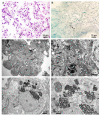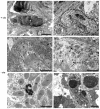Cobalt Ferrite Magnetic Nanoparticles for Tracing Mesenchymal Stem Cells in Tissue: A Preliminary Study
- PMID: 35955869
- PMCID: PMC9368918
- DOI: 10.3390/ijms23158738
Cobalt Ferrite Magnetic Nanoparticles for Tracing Mesenchymal Stem Cells in Tissue: A Preliminary Study
Abstract
Therapy with mesenchymal stem cells (MSCs) is promising in many diseases. Evaluation of their efficacy depends on adequate follow-up of MSCs after transplantation. Several studies have shown that MSCs can be labeled and subsequently visualized with magnetic nanoparticles (NPs). We investigated the homing of MSCs labeled with magnetic cobalt ferrite NPs in experimentally induced acute kidney injury in mice. To explore the homing of MSCs after systemic infusion into mice, we developed a pre-infusion strategy for optimal tracing and identification of MSCs with polyacrylic acid-coated cobalt ferrite (CoFe2O4) NPs by light and transmission electron microscopy (TEM) in various organs of mice with cisplatin-induced acute kidney injury and control mice. By correlative microscopy, we detected MSCs labeled with NPs in the lungs, spleen, kidney, and intestine of cisplatin-treated mice and in the lungs and spleen of control mice. Our results confirm that labeling MSCs with metal NPs did not affect the ultrastructure of MSCs and their ability to settle in various organs. This study demonstrates the usefulness of cobalt ferrite NPs in ex vivo visualization of MSCs and offers correlative microscopy as a useful method in routine histopathology laboratories for tracing MSCs in paraffin-embedded tissue.
Keywords: markers; mesenchymal stem cells; metal nanoparticles; tissue injury.
Conflict of interest statement
The authors declare no conflict of interest.
Figures




Similar articles
-
The effects of superparamagnetic iron oxide nanoparticles-labeled mesenchymal stem cells in the presence of a magnetic field on attenuation of injury after heart failure.Drug Deliv Transl Res. 2018 Oct;8(5):1214-1225. doi: 10.1007/s13346-018-0567-8. Drug Deliv Transl Res. 2018. PMID: 30128798
-
In vivo magnetic resonance imaging of iron oxide-labeled, intravenous-injected mesenchymal stem cells in kidneys of rabbits with acute ischemic kidney injury: detection and monitoring at 1.5 T.Ren Fail. 2015;37(8):1363-9. doi: 10.3109/0886022x.2015.1073542. Epub 2015 Aug 7. Ren Fail. 2015. PMID: 26248484
-
The impact of silica encapsulated cobalt zinc ferrite nanoparticles on DNA, lipids and proteins of rat bone marrow mesenchymal stem cells.Nanotoxicology. 2016 Aug;10(6):662-70. doi: 10.3109/17435390.2015.1107144. Epub 2015 Nov 18. Nanotoxicology. 2016. PMID: 26581309
-
Applications of cobalt ferrite nanoparticles in biomedical nanotechnology.Nanomedicine (Lond). 2018 May;13(10):1221-1238. doi: 10.2217/nnm-2017-0379. Epub 2018 Jun 8. Nanomedicine (Lond). 2018. PMID: 29882719 Review.
-
Nanoparticle-dependent labeling of mesenchymal stem cell.J Nanosci Nanotechnol. 2014 Jan;14(1):958-68. doi: 10.1166/jnn.2014.9113. J Nanosci Nanotechnol. 2014. PMID: 24730312 Review.
Cited by
-
Human umbilical cord-derived mesenchymal stem cells improve thymus and spleen functions in D-galactose-induced aged mice.Sci Rep. 2025 Mar 19;15(1):9470. doi: 10.1038/s41598-025-94364-9. Sci Rep. 2025. PMID: 40108399 Free PMC article.
-
Immunomodulatory effects of mesenchymal stem cell therapy in chronic kidney disease: a literature review.BMC Nephrol. 2025 Mar 3;26(1):107. doi: 10.1186/s12882-025-04029-y. BMC Nephrol. 2025. PMID: 40033224 Free PMC article. Review.
-
Worldwide hotspots and trends in stem cell therapy for kidney disease in the last decade: a bibliometric and visualization analysis from 2015 to 2024.Front Immunol. 2025 Jul 21;16:1619291. doi: 10.3389/fimmu.2025.1619291. eCollection 2025. Front Immunol. 2025. PMID: 40761782 Free PMC article.
References
-
- Gnecchi M., Danieli P., Malpasso G., Ciuffreda M.C. Paracrine Mechanisms of Mesenchymal Stem Cells in Tissue Repair. Methods Mol. Biol. 2016;1416:123–146. - PubMed
MeSH terms
Substances
Grants and funding
LinkOut - more resources
Full Text Sources

